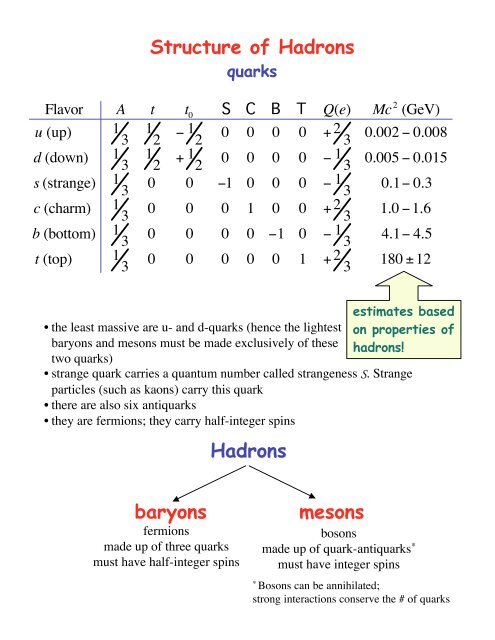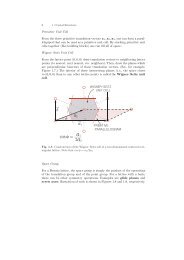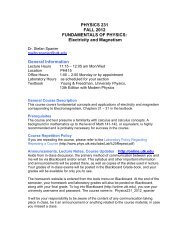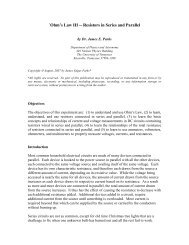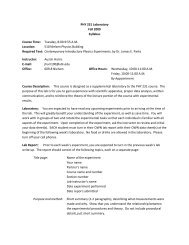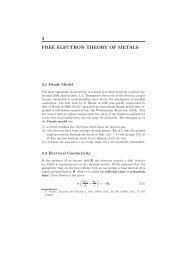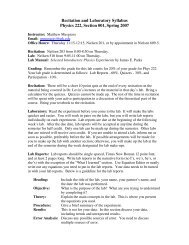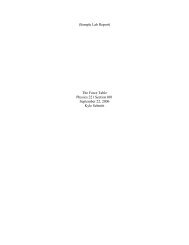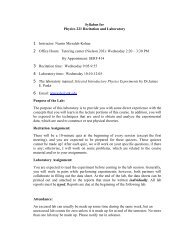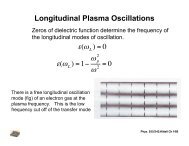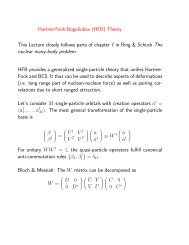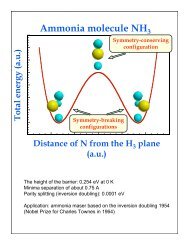Structure of Hadrons Hadrons baryons mesons
Structure of Hadrons Hadrons baryons mesons
Structure of Hadrons Hadrons baryons mesons
Create successful ePaper yourself
Turn your PDF publications into a flip-book with our unique Google optimized e-Paper software.
<strong>Structure</strong> <strong>of</strong> <strong>Hadrons</strong>isospin <strong>of</strong> quarksp = uud n = uddd- and u-quarks form an isospin doublett ±(nucleon) Æ t ±(q i)3Âi=1t +u = dt -d = uquark wave functions <strong>of</strong> pionsConsider p - (t=1 and t 0 =1). The only possible combination isp -= u dIn general, it is possible to find several linearly independent componentscorresponding to the same t and t 0 . The appropriate combination is given byisospin coupling rules. Furthermore, the wave function must beantisymmetric among the quarksp 0 = 1 2 t -p - = 1 2p += - ud( uu - dd )T=1 tripletWhat about the symmetric combination?( uu + dd )h 0= 1 2T=0 singletTo produce heavier <strong>mesons</strong> we have to introduce excitations in thequark-antiquark system or invoke s- and other more massive quarks
<strong>Structure</strong> <strong>of</strong> <strong>Hadrons</strong>strange <strong>mesons</strong>The lightest strange <strong>mesons</strong> are kaons or K-<strong>mesons</strong>. They come in twodoublets with t=1/2:{ K + (us), K 0 (ds)}, K - (u s),K 0 (d s){ }This means that s-quark has zero isospin (no strange <strong>mesons</strong> witht=3/2 have been seen),Q = -t 0+ 1 2( A+ S +C +B +T ) generalizationp - (u d) + p(uud) Æ K 0 (ds ) + L(uds)strangeness isconserved!Strong interactions conserve the total number <strong>of</strong> each type <strong>of</strong> quarks.However, quarks can be transformed from one flavor to anotherthrough weak interactions (CKM matrix!).
<strong>Structure</strong> <strong>of</strong> <strong>Hadrons</strong>colorConsider a D-particle. It has isospin 3/2 with four different charge states:D - ,D 0 ,D + ,D ++Since it is nonstrange baryon, is has to be made <strong>of</strong> u- and d-quarks. D ++ hasQ=2 and the only possiblity is a (uuu) combination. The intrinsic parity <strong>of</strong>D ++ is known to be positive, its intrinsic spin is 3/2, and isospin is also 3/2.How to get the wave function that is untisymmetric with respect to apermutation <strong>of</strong> any two <strong>of</strong> the three quarks? Is Pauli wrong?Color saves the day. It is a property <strong>of</strong> quarks. There are three colors: R(red), G (green) and B (blue). The wave function has to be antisymmetric inthe color degree <strong>of</strong> freedom: the net color in hadron must vanish!Since color is an unobserved property, all hadrons must be colorless oblects!


